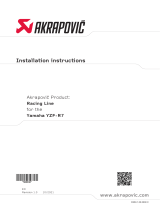
TABLE OF CONTENTS
SAFETY INFORMATION ..................1-1
DESCRIPTION ..................................2-1
Left view ..........................................2-1
Right view........................................2-2
Controls and instruments.................2-3
INSTRUMENT AND CONTROL
FUNCTIONS .......................................3-1
Main switch/steering lock ................3-1
Indicator and warning lights ............3-2
Tachometer ....................................3-3
Multi-function display ......................3-3
Handlebar switches ........................3-4
Clutch lever .....................................3-5
Shift pedal .......................................3-6
Brake lever .....................................3-6
Brake pedal ....................................3-6
Fuel tank cap ..................................3-7
Fuel .................................................3-7
Catalytic converters ........................3-8
Rider seat .......................................3-9
Anti-theft device housing ................3-9
Sidestand ......................................3-10
Ignition circuit cut-off system ........3-10
PRE-OPERATION CHECKS..............4-1
Pre-operation check list ..................4-2
OPERATION AND IMPORTANT
RIDING POINTS................................. 5-1
Starting the engine ......................... 5-1
Shifting ........................................... 5-2
Tips for reducing fuel
consumption ...............................5-3
Engine break-in .............................. 5-3
Parking ........................................... 5-4
PERIODIC MAINTENANCE AND
MINOR REPAIR ................................. 6-1
Owner’s tool kit ............................... 6-1
Periodic maintenance and
lubrication chart .......................... 6-2
Removing and installing the
cowlings and panel ..................... 6-6
Checking the spark plug ................. 6-8
Engine oil and oil filter element ...... 6-9
Coolant ......................................... 6-12
Replacing the air filter element
and cleaning the check hose .... 6-14
Adjusting the engine idling
speed ........................................ 6-14
Adjusting the throttle cable free
play ........................................... 6-15
Valve clearance ............................ 6-16
Tires ............................................. 6-16
Cast wheels .................................. 6-18
Adjusting the clutch lever free
play ........................................... 6-19
Checking the front brake lever
free play .................................... 6-20
Adjusting the brake pedal free
play ........................................... 6-20
Checking the front and rear
brake pads ................................ 6-20
Checking the brake fluid level ...... 6-21
Changing the brake fluid .............. 6-22
Drive chain slack .......................... 6-22
Cleaning and lubricating the
drive chain ................................ 6-24
Checking and lubricating the
cables ....................................... 6-24
Checking and lubricating the
throttle grip and cable ............... 6-25
Checking and lubricating the
brake and shift pedals .............. 6-25
Checking and lubricating the
brake and clutch levers ............ 6-26
Checking and lubricating the
sidestand .................................. 6-26
Lubricating the swingarm
pivots ........................................ 6-27
Checking the front fork ................. 6-27
Checking the steering .................. 6-28
Checking the wheel bearings ....... 6-28
Battery ......................................... 6-29
Replacing the fuses ..................... 6-30
Replacing a headlight bulb .......... 6-31
Tail/brake light ............................. 6-31
U5D7E0E0.book Page 1 Tuesday, December 18, 2007 10:13 AM




















